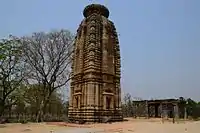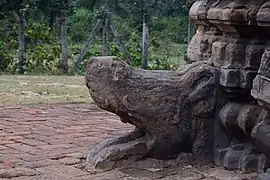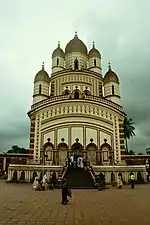Banda Deul
Banda Deul is an 11th-century temple in Banda village (also called Deulghera) in the Raghunathpur II CD block in the Raghunathpur subdivision of the Purulia district in the state of West Bengal, India.
| Banda Deul | |
|---|---|
| Religion | |
| Affiliation | Jainism/Hinduism |
| Location | |
| Location | Banda Purulia district |
| State | West Bengal |
| Country | India |
 Shown within West Bengal  Banda Deul (India) | |
| Geographic coordinates | 23.6074°N 86.5587°E |
| Architecture | |
| Type | Rekha deul |
| Completed | 11th century |
Geography
| Places in Raghunathpur subdivision in Purulia district M: municipal town, CT: census town, R: rural/ urban centre, H: historical/ religious centre, T: tourist centre Owing to space constraints in the small map, the actual locations in a larger map may vary slightly |
Location
Banda is located at 23.6074°N 86.5587°E.
Banda is 1 km from Cheliyama, which contains the Radha Vinod temple with the most richly decorated terracotta carvings.[1]
There are three dilapidated deuls at Para, located nearby, belonging to the 10-11th century or earlier.[2]
Note: The map alongside presents some of the notable locations in the subdivision. All places marked in the map are linked in the larger full screen map.
Banda Deul
There is a temple at Banda, which is described by the Archaeological Society of India as a rekha deul of triratha variety in sand stone. “The temple is richly decorated, the themes being creepers, scroll work and stylised chaitya window.” The temple was built around the 11th century.[3]
In 1872, the archaeologist J.D.Beglar came across this temple, then covered with deep vegetation in a forest. The area around the deul was cleared and it started attracting attention. Adrish Bardhan, a science fiction enthusiast and writer, established that the structure of the Banda deul was vandalised by the soldiers of Firuz Shah Tughlaq in 1360. “It is not clear whether it was a Hindu or a Jain temple. The jagmohan part of the temple (the middle tier of a typical Odisha-style three-tier temple) was never completed and the peerless floral designs carved on soft stone on the front façade were badly defaced. The circled crown on the top (known as amalaka) was also broken.” [4]
The temple had a mandapa which has largely collapsed, However, eight pillars are still there supporting the cross beams. The temple has an water outlet with a makara (crocodile) head.[1]
According to the List of Monuments of National Importance in West Bengal the old temple at Banda is a monument of national importance.[5]
Banda picture gallery
 The deul at Banda with remains of the mandapa
The deul at Banda with remains of the mandapa The deul at Banda
The deul at Banda Stone decoration
Stone decoration Crocodile head shaped water outlet
Crocodile head shaped water outlet
Pictures are a part of Wiki Explores Purulia programme, an initiative by West Bengal Wikimedians User Group
References
- "District Census Handbook, Puruliya, Series 20, Part XII A" (PDF). Banda - Page 101: Brief Description of Places of Religious, Historical or Archaeological Importance and Places of Tourist Importance of the District. Directorate of Census Operations, West Bengal. Retrieved 23 January 2020.
- Dutta, Rangan. "Temples of Para, Purulia". Wordpress. Retrieved 10 January 2020.
- "Old temple at Banda (locally known as deul)". ASI, Kolkata Circle. Retrieved 23 January 2020.
- Sengupta, Somen. "Next weekend you can be at… Banda". The Telegraph. Retrieved 23 January 2020.
- "List of Ancient Monuments and Archaeological Sites and Remains of West Bengal - Archaeological Survey of India". Item no. 134. ASI. Retrieved 25 January 2020.
